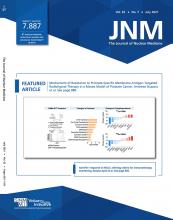TO THE EDITOR: Various nuclear medicine associations and colleagues (1–6) have discussed whether a ventilation examination should be included at all when performing ventilation–perfusion (V/Q) scans for diagnosis of pulmonary embolism during the severe acute respiratory syndrome coronavirus 2 (SARS-CoV-2) pandemic. This consideration was prompted by the concern that a ventilation scan may be an aerosol-prone maneuver and, thus, carry a potential risk of infecting the personnel. Usually, the V/Q scan procedure starts with a ventilation scan, which is followed by a perfusion scan and is eventually closed with a low-dose CT scan, if available. This sequence is traditionally chosen for a V/Q scan because it is easier to surpass the ventilation activity with the perfusion marker than vice versa. Instead of completely eliminating the ventilation scan, resulting in a reduction in specificity (7) and all its negative consequences—such as bleeding events due to unnecessary anticoagulation—we suggest modification of the workflow during the pandemic such that the scan routinely starts with perfusion SPECT (with a somewhat lower administered activity than usual, associated with an increased acquisition time) and proceeds with low-dose CT, if applicable. Ventilation SPECT (with a somewhat higher administered activity than usual, associated with a decreased acquisition time) would be performed only when there are perfusion deficits that are not sufficiently explained by structural findings on low-dose CT. If the patient is SARS-CoV-2–positive or there are COVID-like findings on low-dose CT, it would remain at the discretion of the physician whether a ventilation scan is performed, under appropriate security measures. By doing so, we can reduce the number of ventilation scans and avoid the aforementioned discussion by various nuclear medicine associations and colleagues (1–6).
Figure 1 shows a representative example of the proposed approach in a recently bedridden 80-y-old woman with dyspnea, thoracic pain, and an increased D-dimer level who was referred from an external hospital to rule out pulmonary embolism. We started by injecting about 45 MBq of 99mTc-macroaggregated albumin and performing perfusion SPECT/CT. Since we found relevant perfusion deficits and unremarkable findings on low-dose CT, we subsequently also performed ventilation SPECT with about 88 MBq of 99mTc-Technegas (Cyclomedica) (net ventilated activity calculated from the projection data). The ventilation and perfusion studies showed mismatched findings typical of pulmonary embolism (Fig. 1A). In combination with the normal results from the low-dose CT examination (Fig. 1B), these finding allowed us to detect pulmonary embolism with the highest degree of certainty, according to Gutte et al. (7).
V/Q SPECT/CT scan of 80-y-old woman. (A) Slice-by-slice comparison of ventilation and perfusion SPECT showing mismatched findings in both lungs (arrows). Image noise is higher in perfusion images because of lower administered activity in inverted-workflow protocol. (B) Combining SPECT data with low-dose CT proves pulmonary embolism in absence of structural alterations.
Overall, we believe that the suggested routine reversal of the traditional workflow helps to minimize aerosol-prone and potentially infectious maneuvers without compromising the accuracy of pulmonary embolism diagnostics.
Footnotes
Published online May 7, 2021.
- © 2021 by the Society of Nuclear Medicine and Molecular Imaging.








